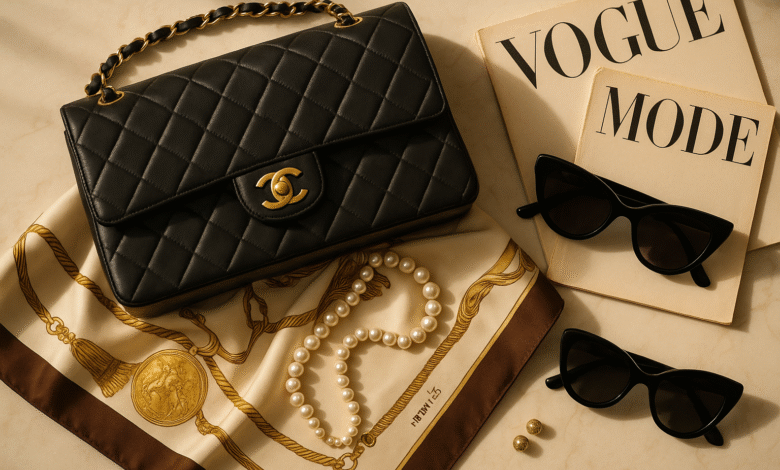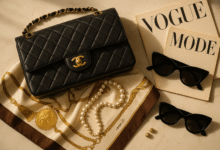Vintage Designer Pieces: Investment Fashion That Pays Off
Discover how vintage designer pieces offer impressive investment returns. Learn which luxury items appreciate in value and build a profitable fashion portfolio.

The fashion world has witnessed a remarkable shift toward vintage designer pieces as savvy consumers discover the dual benefits of owning timeless luxury items. These carefully curated fashion investments offer both personal style satisfaction and impressive financial returns, making vintage designer pieces an increasingly attractive alternative to traditional investment options.
Unlike fast fashion that loses value immediately after purchase, vintage designer pieces often appreciate over time, especially items from renowned fashion houses with rich histories. The growing awareness of sustainable fashion practices, combined with the desire for unique, high-quality pieces, has created a thriving market for pre-owned luxury goods.
EXPLORE THE CONTENTS
Understanding the Vintage Designer Market
What Defines Vintage Designer Pieces
Vintage designer pieces typically refer to luxury fashion items that are at least 20 years old, created by established fashion houses or influential designers. These pieces represent specific eras in fashion history and showcase the craftsmanship and design philosophy of their time. The most sought-after vintage designer pieces come from iconic brands like Chanel, Hermès, Louis Vuitton, Dior, and Gucci.
The authenticity and provenance of vintage designer pieces play crucial roles in determining their investment value. Items with clear ownership history, original packaging, and authentication certificates command higher prices in the luxury resale market. Fashion collectors and investors increasingly recognize that certain vintage designer pieces can outperform traditional investment vehicles like stocks or bonds.
The Evolution of Fashion Investment
The concept of fashion as investment has evolved significantly over the past decade. What once was considered mere consumption has transformed into a sophisticated investment strategy. Vintage designer pieces now feature in investment portfolios alongside traditional assets, with some pieces showing annual appreciation rates that rival real estate investments.
This shift reflects changing consumer attitudes toward luxury consumption. Modern buyers seek pieces with lasting value, both aesthetically and financially. The rise of fashion authentication services and online luxury resale platforms has made investing in vintage designer pieces more accessible and secure than ever before.
Also Read: Makeup vs. Skincare: Where Should You Invest More?
Top Categories of Investment-Worthy Vintage Designer Pieces
Designer Handbags: The Gold Standard
Designer handbags represent the most reliable category within vintage designer pieces for investment purposes. Iconic bags from Hermès, particularly the Birkin and Kelly models, have shown consistent appreciation over decades. These pieces often exceed their original retail prices within years of purchase, with rare or limited-edition versions achieving astronomical values at auction.
Chanel quilted bags, especially those from the brand’s golden era under Coco Chanel and Karl Lagerfeld, remain highly coveted vintage designer pieces. The classic 2.55 flap bag, introduced in 1955, continues to appreciate in value, particularly in rare colors or exotic materials. Louis Vuitton’s collaboration pieces and limited editions from the early 2000s have also proven to be excellent investments.
The key to successful handbag investment lies in understanding which styles have achieved iconic status. Vintage designer pieces that represent turning points in fashion history or showcase exceptional craftsmanship tend to perform best in the investment market.
Haute Couture and Ready-to-Wear Garments
Vintage couture pieces from legendary fashion houses offer unique investment opportunities for those with larger budgets and proper storage capabilities. Garments from designers like Christian Dior’s “New Look” era, Yves Saint Laurent’s revolutionary designs, or Thierry Mugler’s architectural creations have shown remarkable appreciation over time.
Ready-to-wear pieces from significant fashion movements also qualify as valuable vintage designer pieces. Items from the punk fashion era, 1980s power dressing, or 1990s minimalism can command impressive prices when they represent important cultural moments or showcase innovative design techniques.
The condition of vintage designer pieces in this category significantly impacts their investment potential. Well-preserved garments with minimal wear, original tags, or designer alterations often achieve the highest returns. Professional conservation and proper storage are essential for maintaining the investment value of these pieces.
Jewelry and Accessories
Vintage jewelry from fashion houses extends beyond traditional precious metals and stones to include costume jewelry that has achieved cult status. Chanel’s pearl necklaces, Dior’s statement brooches, or Hermès’ silk scarves represent accessible entry points into vintage designer pieces investment.
These accessories often provide the best return on investment relative to their initial cost. A vintage Hermès scarf purchased for hundreds of dollars decades ago might now be worth thousands, especially if it features sought-after patterns or collaborations with famous artists.
The portability and durability of jewelry and accessories make them practical vintage designer pieces for both wearing and investment. Unlike clothing, these items are less susceptible to sizing issues and can be enjoyed by multiple generations while appreciating in value.
Factors That Drive Value in Vintage Designer Pieces
Brand Heritage and Designer Legacy
The investment potential of vintage designer pieces closely correlates with the lasting influence of their creators. Pieces from designers who fundamentally changed fashion history tend to maintain and increase their value over time. Items from Coco Chanel, Christian Dior, Yves Saint Laurent, or Gianni Versace benefit from their creators’ enduring legacies in fashion history.
Brand consistency and continued relevance also impact investment potential. Fashion houses that maintain their luxury positioning and continue to honor their heritage while innovating for contemporary markets see their vintage designer pieces appreciate more consistently. The current popularity and cultural relevance of a brand significantly influence the demand for its vintage pieces.
Limited production runs, discontinued styles, and pieces from significant fashion moments create scarcity that drives value appreciation. Vintage designer pieces that represent “firsts” in fashion history or showcase groundbreaking techniques often become the most valuable investments over time.
Condition and Authenticity
The condition of vintage designer pieces directly impacts their investment value, with mint or near-mint condition items commanding premium prices. Professional authentication services have become essential in the vintage luxury market, as the proliferation of high-quality reproductions makes expert verification crucial for investors.
Authentication involves examining construction techniques, materials, hardware, and other details that counterfeiters often overlook. Reputable authentication services provide certificates that significantly enhance the resale value of vintage designer pieces. The provenance, or ownership history, can also add considerable value, especially if the piece has celebrity or historical significance.
Proper maintenance and storage of vintage designer pieces require investment in conservation techniques. Climate-controlled storage, professional cleaning, and careful handling can preserve investment value over decades. Some investors employ professional conservation services to maintain their vintage designer pieces in optimal condition.
Market Trends and Cultural Relevance
The investment performance of vintage designer pieces often reflects broader cultural trends and fashion cycles. The current revival of Y2K fashion has driven up prices for late 1990s and early 2000s designer pieces. Similarly, the growing interest in sustainable fashion has increased demand for all categories of vintage designer pieces.
Social media influence plays an increasingly important role in determining which vintage designer pieces experience price appreciation. When celebrities or influencers feature specific vintage pieces, market demand often surges immediately. This phenomenon has created new opportunities for informed investors who can anticipate trend cycles.
The cyclical nature of fashion means that vintage designer pieces from different eras experience waves of popularity and corresponding price increases. Understanding these cycles and positioning investments accordingly can significantly enhance returns on vintage designer pieces.
Building a Vintage Designer Investment Portfolio
Starting Your Collection
Beginning a vintage designer pieces investment portfolio requires careful research and strategic planning. New investors should start with well-established pieces from recognized brands rather than gambling on emerging designers or trendy pieces. Building knowledge about specific brands, their history, and their most iconic designs provides the foundation for successful investing.
Education about authentication, condition assessment, and market values is essential before making significant purchases. Many successful vintage designer pieces investors start by attending auctions, visiting reputable consignment shops, and studying price histories of specific items. This hands-on education helps develop the expertise necessary for making informed investment decisions.
Setting clear investment goals and budget parameters helps guide purchasing decisions. Some investors focus on wearable pieces that provide personal enjoyment alongside financial returns, while others treat vintage designer pieces purely as financial instruments and prioritize appreciation potential over personal preference.
Diversification Strategies
Successful vintage designer pieces investment portfolios typically include items from multiple categories and eras. Diversifying across handbags, jewelry, clothing, and accessories helps minimize risk while maximizing opportunities for appreciation. Geographic diversification, including pieces from European, American, and Asian designers, can also enhance portfolio stability.
Price point diversification allows investors to participate in different segments of the vintage designer market. Combining high-value investment pieces with more accessible items creates opportunities for both significant appreciation and steady returns. This approach also allows investors to learn and gain experience across different market segments.
Timing diversification involves acquiring vintage designer pieces across different time periods rather than concentrating purchases in specific market conditions. This strategy helps smooth out market fluctuations and ensures participation in various appreciation cycles that different eras of vintage designer pieces may experience.
Where to Buy and Sell Vintage Designer Pieces
Reputable Sources for Acquisition
Auction houses like Christie’s, Sotheby’s, and specialized fashion auction companies provide transparent markets for high-end vintage designer pieces. These venues offer professional authentication, detailed provenance information, and established price discovery mechanisms that help investors make informed decisions.
Luxury consignment shops with strong reputations for authentication and quality curation offer more accessible entry points for vintage designer pieces investment. Many of these businesses employ experts who understand the investment potential of different pieces and can provide valuable guidance to collectors.
Online platforms have revolutionized access to vintage designer pieces, but they require careful navigation to avoid authentication issues. Platforms with rigorous authentication processes and buyer protection policies provide safer environments for investment purchases. Professional dealers who specialize in specific brands or eras often offer the most reliable sources for serious investors.
Exit Strategies and Selling Considerations
Developing exit strategies for vintage designer pieces investments requires understanding various selling channels and their associated costs and benefits. Auction houses provide maximum exposure and price discovery for high-value pieces but charge significant commissions and may require lengthy consignment periods.
Direct sales to collectors or through specialized dealers can provide quicker liquidity and lower transaction costs but may result in lower realized prices. Online platforms offer broad market access but require careful presentation and marketing to achieve optimal returns on vintage designer pieces investments.
Timing sales to coincide with fashion trends, cultural moments, or seasonal demand patterns can significantly impact realized returns. Understanding market cycles and having flexibility in timing sales allows investors to optimize their returns on vintage designer pieces.
The Future of Vintage Designer Investment
Emerging Trends and Opportunities
The integration of technology in authentication and provenance tracking is creating new opportunities in the vintage designer pieces market. Blockchain technology and digital certificates are beginning to provide immutable records of ownership and authenticity that could enhance investment security and liquidity.
Younger demographics are driving increased demand for vintage designer pieces as they prioritize sustainability and uniqueness over novelty. This generational shift suggests continued growth in the vintage luxury market and sustained appreciation potential for well-chosen investment pieces.
The globalization of luxury markets is expanding demand for vintage designer pieces beyond traditional Western markets. Growing wealth in Asia and other regions is creating new buyer pools for investment-quality vintage pieces, potentially driving continued price appreciation.
Sustainability and Ethical Considerations
The environmental impact of fast fashion is driving consumers toward vintage designer pieces as sustainable alternatives to new luxury goods. This trend aligns investment potential with environmental consciousness, creating additional demand drivers beyond pure financial considerations.
The circular economy concept is becoming increasingly important in luxury fashion, with brands themselves entering the vintage and resale markets. This corporate recognition of vintage value helps legitimize vintage designer pieces as investment vehicles and may provide additional liquidity options in the future.
Social responsibility considerations are also influencing vintage designer pieces investment, as buyers seek to support sustainable consumption patterns while building wealth. This alignment of values with investment strategy may sustain long-term demand for vintage luxury goods.
Conclusion
Vintage designer pieces represent a unique investment category that combines personal enjoyment with financial returns. The growing appreciation for craftsmanship, sustainability, and fashion history continues to drive demand for these timeless luxury items. Success in this investment category requires education, patience, and careful selection of pieces with proven track records and lasting appeal.
The convergence of cultural trends favoring sustainability, the globalization of luxury markets, and technological advances in authentication creates a favorable environment for vintage designer pieces investment. While this market requires specialized knowledge and careful execution, the potential returns and personal satisfaction make vintage designer pieces an increasingly attractive addition to diversified investment portfolios.
As the luxury fashion industry continues to evolve, vintage designer pieces offer investors the opportunity to own pieces of fashion history while potentially achieving significant financial returns. The key lies in approaching this market with the same rigor and research that successful investors apply to any asset class, combined with an appreciation for the artistry and cultural significance of these remarkable pieces.







